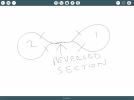Just checking if this will work. Consider a Y junction on a DCC layout.
Normal solution would be to insulate at the points marked 'x' and add a reversing module. For DCC, could we get the same effect by just using a DPDT switch attached to the wye point controller (e.g. LGB supplementary switch 12070) and have it reverse the branch polarity every time the switch is thrown.
Caveats:
Could the same technique work for a conventional reverse loop, as long as you are willing to always throw the points and not rely on push-through?
Code:
-----------
\ /
\ /
x\ /x
|
|Normal solution would be to insulate at the points marked 'x' and add a reversing module. For DCC, could we get the same effect by just using a DPDT switch attached to the wye point controller (e.g. LGB supplementary switch 12070) and have it reverse the branch polarity every time the switch is thrown.
Caveats:
- Need to make sure the wiring is right so the polarity matches the switch branch
- Power will be cut briefly while the switch is thrown, so a stay-alive might be useful
Could the same technique work for a conventional reverse loop, as long as you are willing to always throw the points and not rely on push-through?
Last edited:

